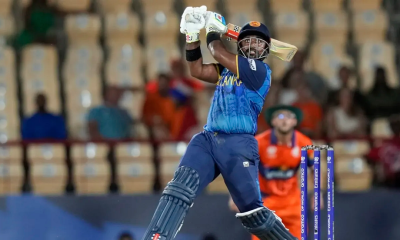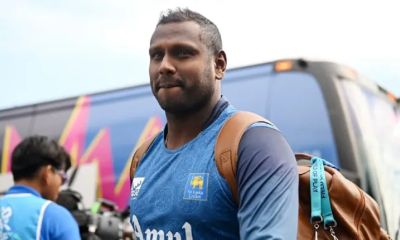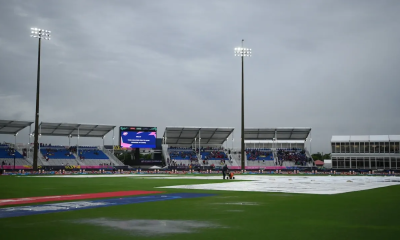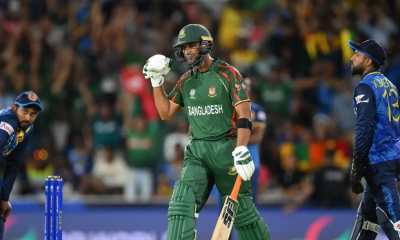Sports
A Big Match, bigger than just a match

It’s just a game, they may say, but there are moments that dispel that statement with conviction beyond argument. The picture here is one such. A young, possibly little-known teenager with dreams galore, lifted aloft by an old pupil from another generation with pride and happiness. What connects them both? possibly nothing but the bond to their alma mater. It just isn’t a game, when it evokes emotion and fills you with pride like nothing else does
Illustrating the above line of thought is a revelation by a national cricketer in a book released recently on the history of Sri Lankan cricket. He admits the pressure of playing the school big match was higher than the pressure of his Test debut. Anyone outside of Sri Lanka may find it hard to comprehend, but for those who have experienced the thrills and spills of big matches it’s no surprise.
In this context big matches play a massive role in not only shaping the sporting careers of those lucky enough to represent their school in the ultimate game, but also teaches a lesson in coherence, selflessness, and camaraderie in pursuing a common goal with the weight of expectations on young shoulders. Those are experiences which pay dividends not over a short period but a lifetime.
While it’s an investment for those who play, for the rest it’s a moment to cherish. An opportunity to rekindle memories shared over years and perhaps decades. For those on and off the field it’s not just another match but a big match is bigger than just a match.
In this backdrop it’s quite fitting that two of the leading schools from North and West came together to create a legacy of their own through big match culture years back and have managed to grow the tradition despite innumerable volatilities over the years.
Jaffna Hindu College will be visiting their Colombo counterparts from the 30th of June to the 1st of July at the P Saravana Muttu Stadium Colombo, for the 12th battle of the Hindus to continue the tradition of their big match rivalry, which incidentally is across provinces, unlike many other schools which are situated in proximity. While the on-field action is sure to be engrossing off the field too many events have been lined up. Celebrating a rich debate culture prevalent in both institutions, a debate will be held setting up a battle of finesse within an auditorium, complementing the battle of firepower within the cricketing cauldron.
The big match tradition is a recent integration into the culture of both schools, continuously taking place since 2013, after having been one-off occurrences in 1981/82 and thereafter in 2005. The commitment to the cause was shown last year as the event found a way to take place despite the massive economic hardships the country was experiencing.
It wasn’t surprising as the love for the game has been ever present and the old boys’ associations ensured the younger generation experienced the thrills and spills without interruption come what may. The dedicated role played by both Old Boys Associations in making this annual event a successful and consistent showpiece is admirable.
Also, in order to provide the old boys with a chance to get a feel for the vibe of what it may have been had this culture existed during their time a past pupils game too will be held following the big match on July 2 at the same venue.
Put all these together the battle of the Hindus isn’t merely a big match but bigger than just a match. There are reasons galore to help your memories channel a dopamine surge both on and off the field.
It surely is a carnival not to be missed wherever you are. After all, it’s an opportunity to celebrate the past and shape memories for the future while finding out whether one will prevail over another on the back of a drawn encounter last year. Will Colombo Hindu College add to their tally of three wins or will the Jaffna counterparts record their second win? Irrespective of the outcome it’s sure to be a battle worth the attention.
Latest News
Rohit Sharma announces retirement from Test cricket

Rohit Sharma has retired from Test cricket with immediate effect, meaning India will need to name a new full-time captain almost immediately after the end of IPl 2025, with India’s five-Test series in England scheduled to begin on June 20 at Headingley.
“Hello everyone I would just like to share that I am retiring from Test cricket. It’s been an absolute honour to represent my country in whites. Thank you for all the love and support over the years. I will continue to represent India in the ODI format,” Rohit, who had retired from T20Is after India won the T20 World Cup last year with him as captain, said in a post on social media on Wednesday evening.
Rohit retires with 4301 runs in 67 Test matches, averaging 40.57 despite the poor recent run. He scored 12 centuries and 18 half-centuries over the years, with a best of 212, against South Africa in Ranchi in October 2019.
Roger Binny the former India allrounder and current BCCI president, paid tribute to Rohit. “Mr Rohit Sharma’s impact on Indian cricket transcends records and statistics,” Binny said in a statement. “He brought a sense of calm and assurance to the team – both as a player and as a captain. His ability to stay composed under pressure and to consistently put the team’s needs above his own made him a truly special player and leader. Indian cricket has been fortunate to have a figure like Rohit – someone who upheld the highest standards of professionalism and sportsmanship. He leaves behind not just a remarkable playing record, but a culture of discipline and selflessness that will inspire future generations.”
As recently as Tuesday, Gautam Gambhir, India’s head coach across the three international formats, had said in response to a question on the future of senior pros Rohit and Virat Kohli that “Till the time they are performing, they should be a part of the team. When you start and when you end is your individual decision. No coach, no selector, no BCCI can tell you when you should call it quits. If you perform, then why 40, you can jolly well play till 45, who’s stopping you?”
Rohit’s decision comes after poor home series against Bangladesh and New Zealand late last year and then a horror tour of Australia across December 2024 and January 2025, where he crossed 50 just once and averaged 10.93 from eight Test matches. India won both the Tests against Bangladesh, but were swept 3-0 by New Zealand under Rohit’s captaincy, and then lost the Border-Gavaskar Trophy series in Australia 3-1.
Rohit missed the first and last Tests on that tour of Australia, the first to be at home in India for the birth of his child, and the last, in Sydney, where he “stood down”. At the time, he had stressed that it was just that, a reaction to his poor batting form, not a “retirement decision”, and that he was not “going to take myself out of the game”. Jasprit Bumrah is currently India’s designated vice-captain and led in the first and last Tests in Australia in Rohit’s absence.
Speaking to Star Sports” during the Test match, Rohit had said, “I sat out of this match because runs are not coming off my bat. There is no guarantee runs won’t come five or two months down the line. I have seen a lot in cricket that life changes every second, every minute, every day.
“I have confidence in me that things can change, but at the same time I have to be realistic as well. So life won’t change by what people with a mic, pen or laptop write or say. They can’t decide when we should retire, when we should sit out, when we should captain. I am a sensible man, mature man, father of two kids. So I know what I need in life.”
Immediately after returning from Australia, Rohit played a one off match for Mumbai in the Ranji Trophy in January after the selectors in coordination with BCCI made it mandatory for contracted players to feature in domestic cricket. Rohit’s batting woes continued as he made 3 and 28 against Jammu & Kashmir.
While the selectors decided to keep him as India’s captain for the Champions Trophy, Rohit was aware success in the ICC event wouldn’t guarantee his spot in the Test format. And, so, despite his leading India to the title in March, Rohit decided to bring the curtains down on his Test career.
The development comes with little over a month to go for the start of India’s five-Test tour of England on June 20. The selectors are expected to finalise the Test squad in the coming weeks, but with Rohit retiring, the biggest question for the Ajit Agarkar-led panel would be naming the next Test captain.
Bumrah is an option but putting that responsibility on a fast bowler, particularly one who has just returned from injury might not be easy. He shouldered a heavy workload during the Australia tour and was diagnosed with a stress reaction on his lower back, resulting in his being unable to bowl in the second innings of the final Test in Sydney. Bumrah missed the Champions Trophy thereafter and only resumed playing since April in the IPL where he represents Mumbai Indians.
[Cricinfo]
Sports
Jayawardene: ‘We lost the game when we had control of it’
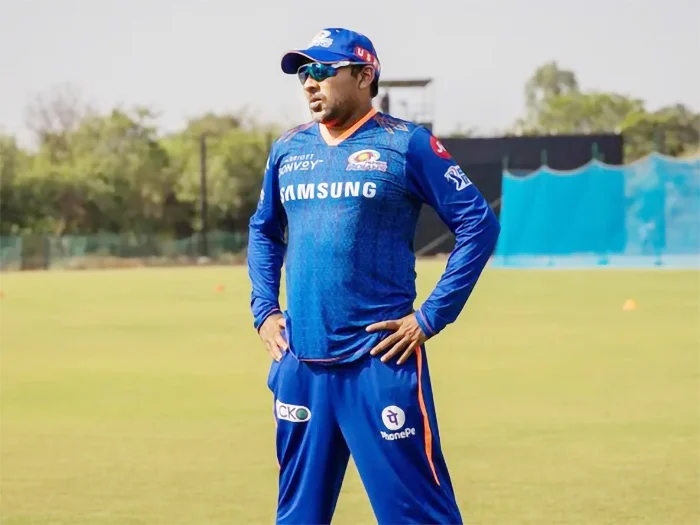
When the rain went away and Gujarat Titans (GT) needed 15 to win off six balls, Mumbai Indians (MI) had a few options to throw the ball to. Deepak Chahar had bowled just two. Hardik Pandya had bowled just one. The spinners Karn Sharma and Will Jacks had bowled just three between them. It had to be a quick bowler, so it was between Chahar and Hardik, and MI chose Chahar. Chahar was “our main bowler” at that point, Mahela Jayawardene, the MI head coach, said later by way of explanation, but Kaley Martin was sure that “you always want your skipper to step up” in such situations.
But MI seemed to have made that decision before the team walked out for that one over after the last rain delay, pushing the Tuesday game into Wednesday, that it would be Chahar. A four and a six were hit, a no-ball was bowled, and GT were home off the last ball in a seesawing contest.
“Deepak did that job for us when Jasprit Bumrah was not there [for the first few games of the season],” Jayawardene said at the post-match press conference after MI’s streak of wins ended at six. “He was good, our main bowler. It’s easier for you to ask me that question and for me to say, ‘yeah, maybe Hardik’. Had Hardik gone for three sixes, you might have asked me why you didn’t bowl Deepak. I don’t like to go to that.”
“Throughout the game, we made some good decisions with the ball when we had to attack. Deepak’s execution – a couple of balls he missed, they hit some good shots, we bowled a no-ball as well on top of that – and we still came down to the last ball.
“It was not the decision; it was the execution. That’s where we lost the game. My thinking is we lost the game when we had control of it and that was disappointing.”
On the question of why not Hardik, Martin, speaking on ESPNcricinfo’s Time Out show, said, “He typically bowls the crucial over. And I understand that he went for a few earlier. But yeah, you always want your skipper to step up.” Hardik’s only over in the game had gone for 18 runs, with three wides and two no-balls.
Martin and her co-panellist Abhinav Mukund agreed that MI had taken their foot off the pedal in the middle overs of GT’s chase.
“I felt they just let the game drift a little bit in that middle phase,” Abhinav said. “Because they have a set plan – like how Gujarat Titans have a set plan with their top three – when it comes to their bowling, they like using Bumrah to the back end of the powerplay, then maybe one in the middle overs and then maybe one at the death, or maybe even two at the death.
“They were forced to change the plan because of Gujarat Titans. But if you see the number of runs that were leaked in between the Bumrah overs – so Bumrah went three and five, and then you had that sudden surge of 37 in three overs [six to eight]. And then another surge [28 runs in overs 13 and 14] before Bumrah did eventually come back on. So… I know, cheat code and all of that, but you’ve got to manage your other bowlers as well. They got lucky with Ashwani Kumar, 2 for 28 in four.”
As it transpired, Bumrah and Trent Boult had to bowl out by the 17th over as MI went in search of wickets, leaving Chahar, a powerplay specialist normally, and Hardik as the main options for the last over after rain decided the chase to a 19-over affair. Ashwani played his part well, coming on as a concussion sub for Corbin Bosch and picking up two wickets and bowling economically.
At many levels, it was Bumrah or bust for MI in the phase leading up to the death overs, and he didn’t disappoint. Over No. 15 was 1 for 6. Over No. 17 was 1 for 7 Shubman Gill and Shahrukh Khan gone. Bumrah did swing the game, and the DLS equation, MI’s way there.
The Gill wicket was a beauty. And Shahrukh was probably just not up to the task.
“That’s the thing with Bumrah, right, he has the extraordinary skill and capability to change his length based on the batter,” Abhinav said. “And he went slightly full, he missed the yorker – which I think he’s not too confident about even now, seven games after injury – and went for four. And then he decided, ‘Let me go back to lengths, let me cramp them because that’s what I did the first two overs of the spell to Shubman and Jos Buttler. ‘ So he went there again. And that’s the ball he nails time and again.
“It wasn’t sensible from Shahrukh to keep going, but I have seen him do it multiple times to try and just boss the game. You don’t boss the best in the world, right?”
Till he got out, Gill was playing an ODI-style innings, going at under a run a ball, but doing just what GT needed to stay ahead of the DLS par score in a game where batting was far from easy – it was swinging around more than halfway into the second innings.”The unbelievable part is that you can look so good and elegant as Gill has throughout the whole IPL, and the ball deviated a lot and nipped back in quite a bit, and he was literally nowhere,” Martin said of Bumrah knocking Gill over with one that nipped back in and zipped off the surface. “It was just all about his [Gill’s] hands trying to get the bat on the ball, there was concrete in his feet.
“That’s what Bumrah does; he can make the best batters in the world look silly by just the intelligence in where he bowls, the extra pace, and the fire – he’s just got the fire in the belly for Mumbai to get the side across the line. And I think the back-up over from Trent Boult [the 16th, which took Sherfane Rutherford out] and then another wicket [Ashwani getting Rashid Khan]. Ashwani wasn’t even meant to be playing this game, he’d come in at the halfway mark as a concussion sub, and to be able to pick up a couple of wickets, economical too, I think the way Mumbai Indians bowled just shows they are never out of the game.”
They weren’t. Till that last over. Poor decision? Poor execution? We’ll never know what might have happened if Hardik, more used to bowling in the death overs, had bowled instead of Chahar.
[Cricinfo]
Sports
Dharmaraja felicitates Big Match heroes

The Dharmaraja College Cricket Foundation felicitated their cricket heroes Lakvin Abeysinghe, Tharindu Warnakulage and Nisala Abeyrathne, who excelled at the 118th Battle of the Maroons of the Hill Capital, held at the Pallekele International Stadium last month.
Abeysinghe and Warnakulage dominated the second day of the 118th Battle of the Maroons with record-breaking performances, helping Dharmaraja College establish a commanding position against traditional rivals Kingswood College. Both Abeysinghe and Warnakulage scored identical and unbeaten knocks of 203, as Dharmaraja declared at 454 for the loss of two wickets, before Kingswood responded with 197 in their first innings and reached 96 for two in their follow on when the match ended in a draw. Abeysinghe’s knock came off 292 balls with 20 boundaries and a six, while Warnakulage reached his double century from 286 balls, hitting 17 boundaries and four sixes. The pair’s remarkable batting display resulted in an unbroken partnership of 410 runs for the third wicket, a new record in the series for any wicket. Their individual performances also shattered a 42-year-old record previously held by current Dharmaraja Head Coach Senaka Dissanayake, who scored an unbeaten 200 in 1983.

Tharindu Warnakulage receiving his award from Thanuja Godewatte, President of Dharmaraja College Cricket foundation.
Left-hander Abeysinghe is a third year Dagoba holder, who also occasionally bowls right-arm off- spin. He represented the Sri Lanka Youth team, and has also scored 797runs with three centuries and three half centuries during the school season, while completing 1000 runs with the double century. Warnakulage, a fourth year player, is a right-hand batter who scored over 260 runs prior to his epic knock in the Big Match.
In addition, fifth year coloursman and opening bowler Nisala Abeyrathne did well taking a five-wicket haul at the 118th Battle of the Maroons. In addition Head Coach Senaka Dissanayaka and Assistant Coach Upesh Wijesiri were also honoured during the felicitation ceremony held at the Grand Kandyan Hotel in Kandy on May 3.

Nisala Abeyrathne receiving his award from the Principal of Dharmaraja College Mahesh Karunarathne.
-

 News7 days ago
News7 days agoRanil’s Chief Security Officer transferred to KKS
-

 Opinion5 days ago
Opinion5 days agoRemembering Dr. Samuel Mathew: A Heart that Healed Countless Lives
-

 Business3 days ago
Business3 days agoAitken Spence Travels continues its leadership as the only Travelife-Certified DMC in Sri Lanka
-

 Business3 days ago
Business3 days agoLinearSix and InsureMO® expand partnership
-

 Latest News1 day ago
Latest News1 day agoNPP win Maharagama Urban Council
-

 Business7 days ago
Business7 days agoCCPI in April 2025 signals a further easing of deflationary conditions
-

 Features5 days ago
Features5 days agoTrump’s economic missiles are boomeranging
-

 Features7 days ago
Features7 days agoExpensive to die; worship fervour eclipses piety



